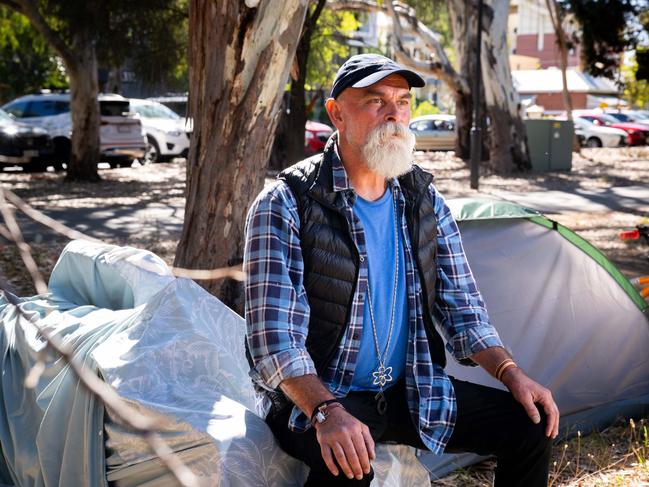Mean streets: On the frontline of Adelaide’s homelessness crisis
Margaret had heard how difficult it had become to find a rental but when she had no idea just how punishing the reality was.

SA Weekend
Don't miss out on the headlines from SA Weekend. Followed categories will be added to My News.
Margaret (not her real name) was devastated to find herself homeless for the first time at the age of 70.
She was ordered to leave her Modbury rental – where she had lived for nine years – by its Queensland-based owner and hurled into the daunting battlefield of hunting for a new home in the middle of a housing crisis.
Application after application was rejected – 104 in total over a soul-destroying 10-week period.
“It was just a shock to realise that I was going to be homeless at 70, I didn’t know what I was going to do or where I was going to go,” says the part-time cleaner, who works about 20 hours a week.
“At my age, you can’t be homeless, you can’t live on the streets. I couldn’t sleep in a car because I didn’t have a car.
“It was quite terrible, really, there was a lot of anxiety. I couldn’t sleep and I had to get up really early to go to work.”
Ten years ago, at the age of 60, Margaret fell on hard financial times after separating from her husband of 25 years and selling the family home, where she had raised her daughter and son.
Initially, she rented a place in Lockleys – “it was quite easy to get a place at that particular time” – before moving to another home closer to her daughter in Modbury.
“That was easy as well … I got the first place I applied for,” she says.
But after being forced out of that property last year, she couch-surfed for a few months at her daughter’s, sharing the small, two-bedroom space with her two granddaughters and son-in-law while trying, in vain, to secure a new home.
“I knew it wasn’t going to be that easy this time to get a rental because all I’d heard for a couple of years was how hard it was to get a property,” she says.
“I probably didn’t think it was going to be as hard as it was but I sure found out pretty quick that it was.
“After a while you go, ‘what’s wrong with me, I’m suitable’. In the end, I just stopped applying for rentals.
“I was thinking ‘what’s the point?’.”
Today, Margaret is living a reversal of fortune after reaching out to Hutt St Centre in desperation and being placed in its Aspire program, which is funded to support homeless people through their ups and downs over a three-year period.
She has moved into a simply furnished one-bedroom apartment decorated with family snaps of her grandchildren, two sisters and mum to “make it feel more homey”. She shares the space with her pet cat.
“I like sitting watching TV on the couch in my new place,” says Margaret, who finds it easy to visit her daughter on public transport from her new southern suburbs flat.
“When I’m sitting there, I’m just happy and safe. I can stay here for as long as I want.”
The Junction community housing property was secured by Margaret’s social worker, Ben Gericke, through the Aspire program.
He has already stuck by her side for 12 months and is funded to keep providing support for another two years.
“I don’t know what I would have done without them,” says Margaret.
“I just felt that Ben was so good, Hutt St Centre were just so good … I knew if I got really down, he could help me.
“I have no idea what would have happened to me if I didn’t have Ben’s ongoing support. For me, the Aspire program has been lifesaving.”
Hard reality of life in a tent

Home for Clive Perkins is a two-man tent pitched under some trees on a tucked-away little hillock in Adelaide’s southern parklands.
Curtains hanging from tree branches give the 61-year-old’s neatly kept campsite a cosy feel.
There’s a mat at the entrance of the tent to wipe his feet, a comfortable chair and a tidy bag to ensure the site is clear of rubbish.
“I’m usually pretty neat and tidy,” says Perkins, who arrived in Adelaide when he was just three, with his Ten Pound Pom parents, and grew up in Hackham with his four siblings.
His campsite is set way back from the tent city that has formed on the corner of Hutt St and South Terrace.
Perkins, who has been sleeping rough in the city since January, likes it that way.
“They take too many drugs, too much of the white stuff,” he says.
“Of course I take drugs but only when I want to. I’ve tried ice but it leaves me with an aching jaw. I might use drugs but I’m not addicted … I don’t go chasing the stuff – if it’s offered to me, I’ve said yes and I’ve said no.”
Inside the Coleman tent, a gift from a homeless mate, there’s sleeping space for two.
Until recently, a friend was bunking down with Perkins but she has been gone for a week.
There’s no blow-up mattress – that’s on loan to a newly homeless man – but the bedding, including a blanket he found near Gluttony during the Fringe, is freshly made.

This is how the disabled pensioner has been living since his driver’s licence was suspended back in January and his Mitsubishi Pajero impounded by police over allegations that he refused a blood-alcohol test – he claims he submitted to a breath test but objected to having blood drawn.
Each day is basically the same.
He gets up about 8am after a night of fitful sleep – which often includes wandering the city streets until the early hours – and makes his way down the road to Hutt St Centre, where he eats breakfast, has a shower and connects with friends.
He usually eats lunch at the centre, too, and heads to the Vinnies Men’s Crisis Centre in Whitmore Square, the Adelaide Day Centre for Homeless Persons in Moore St or the Magdalene Centre in Gilbert St for dinner.
“I get three meals a day. I eat pretty well everyday. Sometimes I go to McDonald’s,” says Perkins, who often likes to have a drink with friends during the day.
“Every day is basically the same.

“You’re at high risk of assault when you sleep on the streets. Your stuff gets stolen. People are your friend one minute, then you’re their archenemy.”
This is not the first time Perkins has slept rough – he’s been on the streets on and off since he was 16, when he was kicked out of home after dropping out of school.
Over the years, he’s made his home at Sydney’s King’s Cross and in a cave on Bondi Beach – “prime location for nix, totally free”.
He’s also had long periods of living with a roof over his head. He shared a home with his two daughters, now aged 38 and 35, and ex-wife until they separated.
A few months ago, he was staying at his former partner’s place in Aldinga Beach before they, too, broke up.
“I’ve been living on the streets at certain times all my life,” says Perkins, who is “riddled with arthritis” – a hangover from a motorcycle accident at the age of 19 – that is exacerbated by the cold.
“I’m okay when I’m not getting pushed around from pillar to post. You get to see how people really live.”
A Ray of hope
But despite success that has seen 81 per cent of Aspire’s 575 clients secure housing, the program – set up in 2017 – is facing an uncertain future.
Hutt St Centre chief executive Chris Burns is now “pleading” with the state government to give assurance that it will keep funding the program, which – by Treasury’s own calculations – has saved nearly $13m in avoided hospitalisations, jail terms and correctional services stays and emergency accommodation over the past six years.
“That doesn’t include the intangibles of emergency ramping, distress from families, other things like that,” Burns says.
The program “relentlessly” supports, guides and nurtures homeless people like Margaret over a three-year period.

Loyal social workers like Gericke stay the course, helping their clients to rebuild their lives – breaking drug and alcohol addictions, securing housing and work, settling fines and legal issues and reconnecting with friends and family.
“We’re there when they meet the housing manager, when they pick up the keys, there on moving day, linking them up with a financial manager,” Burns says.
“The case workers have them applying for jobs, applying for accommodation – that relentless, persistent care to the point where the client just says ‘I’m going to make this work’.”
For those homeless people who aren’t in the Aspire program, like Clive Perkins, Hutt St is funded to provide support for six months. But without ongoing, persistent help, it’s a revolving door, with clients typically returning to the city centre within three to six months.
The government has yet to commit the $15m needed to keep the program running for another seven years.
In last year’s budget, it funded Aspire for just a 12 month extension.

A spokesperson for Treasurer Stephen Mullighan said the longer, seven-year funding was being “considered as part of the various initiatives put forward for the upcoming 2024-25 State Budget by the Minister for Human Services”.
But with no certainty, Burns fears losing his “cream of the crop” social workers, who do not know whether their annual contracts will be renewed in June.
“Aspire has attracted the best because it’s work every social worker wants to do, empowering them to be relentless and stick to people like glue,” he says.
“But there’s a lot of insecurity and uncertainty about (annual contracts), we can’t invest in growth and innovation, all we’re doing is keeping the lights on, effectively. We need a commitment from the state government.”
The Aspire program was set up in 2017 using a unique funding arrangement of a $9m Social Impact Bond backed by private philanthropists.
At the end of the six-year period, the state government paid the private funder the maximum $20m return stipulated in the Aspire agreement.
But official figures calculated by Treasury and Deloitte show the program saved the government nearly $33m – $14.6m in reduced hospital stays, criminal procedures and other services and another $18.1m in services that had been avoided for the future.
Hutt St Centre calculates the return of a seven-year, $15m commitment will be a “conservative” $35m.
“I’d love to get that on my investment,” Burns says.
“They’ll save $35m and more because we are keeping people out of hospital, out of jail, not paying very expensive emergency accommodation.
“But then there’s a whole series of intangibles that haven’t been factored in. It saves federal money by helping homeless people go off benefits and earn a taxpaying wage.
“Stop thinking of it as an outlay and think of it as an income.
“It’s also taken nearly 600 people off the streets and effectively rebuilt their lives – that’s the greatest motivator.”
And for heartbroken people who find themselves homeless, like 70-year-old Margaret, it “saves lives”.





